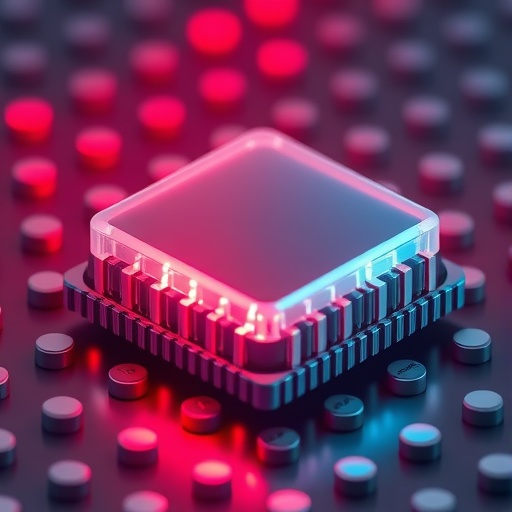In the quest to revolutionize data storage technologies, a remarkable advancement has emerged from the boundary of material science and photonics. Researchers, spearheaded by Andrea Cavalleri and his team, have unveiled a groundbreaking method to manipulate ferroaxial order in solids using terahertz light pulses. This discovery opens a novel avenue for digital information encoding, harnessing a heretofore unexplored form of ferroic order that transcends traditional magnetic and electric polarization mechanisms.
Digital technologies fundamentally rely on binary information encoding, utilizing physical systems that can reliably toggle between two distinct stable states representing ‘0’ and ‘1’. Conventional ferroic materials—such as ferromagnets and ferroelectrics—operate on magnetic or electric dipole states, respectively, to store and manipulate this binary data. While these materials have propelled advancements in memory and data storage paradigms over decades, they inherently suffer from vulnerabilities such as sensitivity to external magnetic interference and gradual material degradation, compromising data fidelity and device durability.
Introducing ferroaxial materials as a novel class within the ferroic family, the research illuminates their unique ability to sustain stable rotational patterns of electric dipoles arranged in vortices. Unlike traditional ferroic orders, ferroaxials neither generate net magnetization nor electric polarization, rendering them intrinsically immune to perturbations by stray magnetic or electric fields. This robustness makes ferroaxials exceptionally promising candidates for reliable, non-volatile information storage; however, their inertness also poses significant challenges in controllability and switching, which until now has limited their practical utility.
The pioneering methodology utilizes circularly polarized terahertz (THz) light pulses to dynamically toggle ferroaxial domains between clockwise and counterclockwise rotations. The underlying mechanism involves synthetic effective fields generated by these ultrafast light pulses interacting with ionic motions in the crystal lattice of rubidium iron dimolybdate (RbFe(MoO₄)₂). This material system exhibits ferroaxiality characterized by its unique lattice symmetry conducive to hosting stable rotatory electric dipole configurations. The THz pulses effectively drive ions in circular trajectories, generating a synthetic field that functions analogously to a magnetic field switching a ferromagnet or an electric field reversing ferroelectric polarization.
By fine-tuning the helicity—the direction of twist—of the circularly polarized terahertz light, the researchers achieved deterministic control over the ferroaxial domain orientation. This selective stabilization of clockwise versus anticlockwise vortex structures in electric dipole arrangements signifies a non-contact, ultrafast, and reversible method for encoding binary information. Unlike magnetization or electric polarization-based systems, such an approach mitigates many known degradation and interference issues, cultivating prospects for durable, high-fidelity data storage platforms.
The potential speed of switching in this ferroelectric-like system is underpinned by the ultrafast nature of terahertz photonics, enabling information writing at unprecedented temporal scales, far surpassing the limitations of traditional magnetic or electric field-driven mechanisms. The non-volatile nature of the ferroaxial states ensures the data retention persists without continuous power, a critical metric for energy-efficient memory devices and long-term data archiving solutions.
Moreover, the synthetic effective field concept employed in this work represents a paradigm shift in controlling solid-state phases. Instead of applying external magnetic or electric fields, the excitation of lattice vibrations—phonons—with specific angular momentum imparts a dynamically tunable field that couples directly to ferroaxial order parameters. This mechanism was first experimentally realized by the same team in 2017 and now stands as a versatile tool in ultrafast material phase engineering.
The robust stability of ferroaxials against external field perturbations also implies increased resilience to environmental fluctuations and electromagnetic interference—a major limitation in current data storage technologies involving ferromagnetic media. This robustness, coupled with the rewritable nature of the ferroaxial domains induced by light, sets the stage for a new generation of memory devices combining speed, endurance, and miniaturization potential.
Additionally, this approach bypasses the need for complex device architectures involving magnetic or electric field application hardware, as optical excitation alone can manipulate the ferroaxial states. This simplification may accelerate integration prospects with photonic circuits, paving the way for hybrid optoelectronic systems that leverage ultrafast optical control over material memory states.
The research, involving a collaborative synergy among the Max Planck Society and the University of Oxford, among others, underscores the interdisciplinary nature vital for breakthroughs in quantum materials and ultrafast photonics. The Max Planck Institute for the Structure and Dynamics of Matter (MPSD) has played a central role, supported by leading-edge imaging and material control facilities, symbolizing how advanced research infrastructure propels frontier science.
In conclusion, the photo-induced, nonvolatile, and rewritable switching of ferroaxial states using terahertz light pulses marks a disruptive advance in information storage technology. It advances fundamental understanding of synthetic fields generated by phonons and highlights quantum materials’ potential in shaping future ultrafast, stable, and energy-efficient data storage paradigms. The combination of resilience, speed, and reversibility embodied in ferroaxial switching could herald transformative progress in digital memory, potentially impacting computing, telecommunications, and beyond.
Subject of Research: Ultrafast control and switching of ferroaxial order in solids using terahertz light pulses for advanced data storage applications.
Article Title: Photo-induced nonvolatile rewritable ferroaxial switching
News Publication Date: 9-Oct-2025
Web References: DOI:10.1126/science.adz5230
Image Credits: © Jörg Harms (MPSD)
Keywords
Ferroaxial materials, terahertz light, synthetic effective fields, nonvolatile memory, ultrafast switching, electric dipole vortices, rubidium iron dimolybdate, phonon control, quantum materials, digital data storage, circularly polarized light, ferroic order.
Tags: advanced memory technologies in material sciencedurability of non-volatile memory systemsenhancing data fidelity with new materialsferroaxial materials for data storageimmunity to magnetic interference in memoryinnovative approaches in data storagelight-activated non-volatile memory technologyovercoming limitations of conventional ferroic materialsphotonics in digital technology advancementsrevolutionary digital information encodingstable rotational patterns of electric dipolesterahertz light pulses in memory devices





